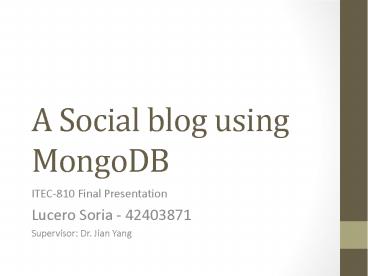A Social blog using MongoDB - PowerPoint PPT Presentation
Title:
A Social blog using MongoDB
Description:
A Social blog using MongoDB ITEC-810 Final Presentation Lucero Soria - 42403871 Supervisor: Dr. Jian Yang Agenda Introduction Methodology Outcomes Blog implementation ... – PowerPoint PPT presentation
Number of Views:260
Avg rating:3.0/5.0
Title: A Social blog using MongoDB
1
A Social blog using MongoDB
- ITEC-810 Final Presentation
- Lucero Soria - 42403871
- Supervisor Dr. Jian Yang
2
Agenda
- Introduction
- Methodology
- Outcomes
- Blog implementation
- MongoDB vs. Relational databases
- Conclusions
3
Agenda
- Introduction
- Methodology
- Outcomes
- Blog implementation
- MongoDB vs. Relational databases
- Conclusions
4
Problem Specification
- Relational Databases Management Systems (RDBMS),
such as MySQL, do not provide the flexibility
and scalability needed to manage social media
data - NoSQL databases, such as MongoDB, emerged to
provide the features that modern applications
demand such as flexibility, scalability and
productivity
5
Project Aim
- Analyse the differences between MongoDB and
relational databases, especially in supporting
social media data
6
Background Sources
- MongoDB
- MongoDB Online Manual
- Online articles
- Relational databases
- MySQL 5.5 reference manual
- Social Media Management Handbook by Robert Wollan
- Online articles
7
Agenda
- Introduction
- Methodology
- Outcomes
- Blog implementation
- MongoDB vs. Relational databases
- Conclusions
8
Project Approach
- This project is a combination of analysis and
development tasks
Research ? MongoDB, social media data and
relational databases
Implement a social blog using MongoDB
Based on the implementation and research
Analyse the differences between MongoDB and
relational databases
9
Methodology
- Incremental methodology was used to implement the
social blog - Combines waterfall model with iterations
10
Agenda
- Introduction
- Methodology
- Outcomes
- Blog implementation
- MongoDB vs. Relational databases
- Conclusions
11
A social blog with MongoDB
- Features implemented
- Login with facebook to create users profile in
MongoDB - Create, edit and delete posts (text, photos or
videos) - Add comments
- Search by tags
- Sort by blogs with more comments
12
Analysis
- Based on our experience implementing the social
blog, the most relevant features to manage social
media data are - Handle irregular data
- Handle large binary objects (videos, photos)
- Operations
- Metadata
- Manage huge volume of data
- Handle geospatial queries
13
Relational data model
- Fixed-schema
- Assume well-defined structure data with a fixed
number of fields (columns) and relationships - Minimize redundancy and dependency ?
Normalization
Source http//blog.jruby.org/
14
Terminology
RDBMS MongoDB
Table Collection
Rows JSON Document
Index Index
Join Embedding Linking
15
Document-oriented data model
- MongoDB uses a document-oriented model using
collections - Main characteristics
- Schema-less
- Collections can be created on-the-fly when first
referenced - Capped collections Fixed size, older records
dropped after limit reached - Collections store documents
16
MongoDB Document
- Main characteristics
- Are represented in a format called BSON (Binary
JSON) - Data is de-normalized
- No joins ? Embedding Linking
- author Lucero',
- created Date(06-06-2012'),
- title 'Yet another blog post',
- text 'Here is the text...',
- tags 'example', lucero' ,
- comments author 'jim', comment 'I
disagree' , - author 'nancy', comment 'Good
post'
17
Storing irregular data
- Example Different information in user profiles
- MongoDB
- Each document can have different information
- doc1 name Joe, age 20, interest
football - doc2 name Michele
- Relational database
- Tables with all attributes
- NULL value in columns where data was not provided
- Results Special queries to handle NULL values ?
Expensive
18
Managing large binary data
- MongoDB
- Divide a large file among multiples documents
(GridFS) - Include metadata to large files
- Search files base on its content
- Retrieve only the first N bytes of a video
- Relational database
- Use BLOB (Binary large objects)
- Inefficient manipulating rich media
- BLOB cannot be searched or manipulated using
standard database command
19
Geospatial Indexes
- Queries to find the nearest N point to a current
location - MongoDB
- Embedded Geospatial features
- Relational database
- Spatial extensions
- MySQL implements a subset of the SQL with
Geometry Types environment proposed by Open
Geospatial Consortium (OGC)
20
Managing huge volume of data
- MongoDB
- High performance
- No joins and embedding makes reads and writes
fast - Indexes including indexing of keys from embedded
documents and arrays - Horizontal scalability
- Automatic sharding (auto-partitioning of data
across servers) - Relational database
- Have shown poor performance on certain
data-intensive applications and delivering
streaming media ? Case study Foursquare - Difficult to scale to multiple servers
21
Agenda
- Introduction
- Methodology
- Outcomes
- Blog implementation
- MongoDB vs. Relational databases
- Conclusions
22
Conclusions
- Benefits that MongoDB offers over relational
database - Flexible schema
- High performance
- Manipulation of large object files out of the box
- Embedded geospatial features
- However,
- MongoDB does not replace relational databases
- MongoDB and relational databases can coexist
23
- Thank You!
- QA































